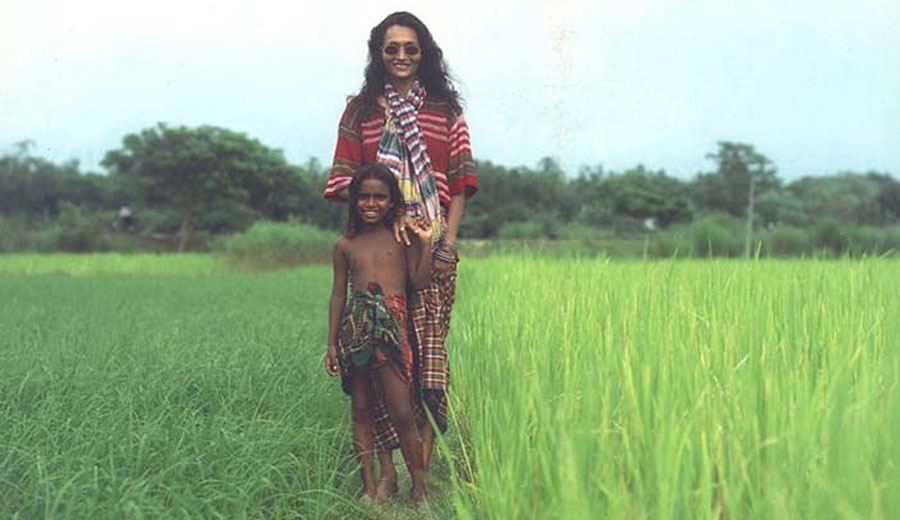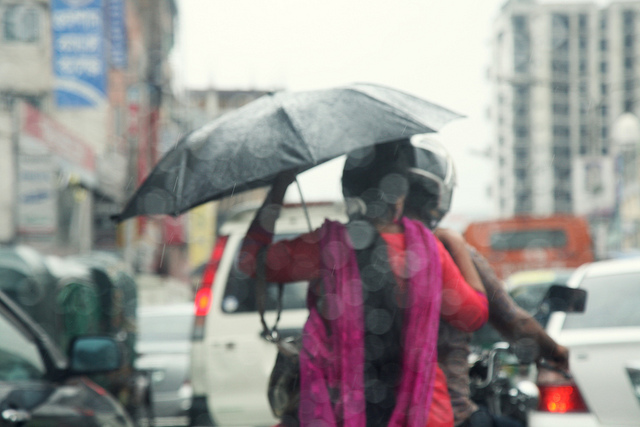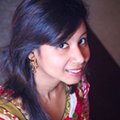Bangladeshi women and today's choices
Nazia Hussein, Department of Sociology
Published March 2014
 Visible signs of cultural or religious belief, and how people respond to them, are significant. It can even result in social inclusion or marginalisation within a society. This is particularly the case for women. Decisions to refuse or adopt particular kinds of dress, make up, hairstyle, and even behaviour profoundly affect women and gender equality in the globalised world. What happened to Tamanna is just one example of the experiences of professional women that I have encountered in my research, which focusses on professional women working for global and local corporate organisations in urban Bangladesh. I aim to illustrate, through my research, that a new version of gendered ‘modernity’ is being constructed among the professional women of Bangladesh.
Visible signs of cultural or religious belief, and how people respond to them, are significant. It can even result in social inclusion or marginalisation within a society. This is particularly the case for women. Decisions to refuse or adopt particular kinds of dress, make up, hairstyle, and even behaviour profoundly affect women and gender equality in the globalised world. What happened to Tamanna is just one example of the experiences of professional women that I have encountered in my research, which focusses on professional women working for global and local corporate organisations in urban Bangladesh. I aim to illustrate, through my research, that a new version of gendered ‘modernity’ is being constructed among the professional women of Bangladesh.
Ethnicity, gender, history, culture and even the space we are in, shapes our everyday experiences in different ways. Our embodiment is therefore experienced in our everyday lives as lived and communicative bodies. However, individuals do not constitute singular, isolated and fixed embodiment practices or identities; we can take on multiple and sometimes contradictory and conflicting influences from the environment around us. Embodied identities are always in the process of becoming, being made and remade, constructed and redefined, shaped and transformed. Bangladeshi professional women are defined both by their private ethnic cultural identities as well as public, professional and Western embodiment practices. What I’ve found most striking is how these women strategize, manipulate and transform both their personal cultural beliefs with their professional lives, creating and defining their own realities in what is a rapidly changing society in Bangladesh.
But how has this pattern emerged? The introduction of economic liberalisation in Bangladesh in the early nineteen-nineties resulted in significant changes, not only within the national economy but also within urban culture. A large number of foreign companies began to invest in Bangladesh and, as a result, the job market expanded and with this a rise in the disposable incomes of the urban middle-class. Simultaneously, Western culture began to proliferate through the launch of satellite television, American magazines and increased foreign travel for work and leisure. These changes were felt across society but they had specific effects on the status of educated and professionally qualified women. Unprecedented numbers of these women were now able to enter the job market. Utilising the opportunities offered by a liberalised economy, Bangladeshi women became exposed to Western values of individualism and sexual openness through the multinational companies they worked for. This individualism interpreted in relation to a woman’s career and economic freedom, and sexual openness interpreted through a woman’s liberal embodiment practices and visibility in the public sphere from where they had long been excluded, is a fairly new phenomenon in Bangladesh.
 Bangladeshi women and girls have long been the symbol of nation and culture; embodying national and cultural customs through their clothing. The sari is considered the ideal nationalist attire for Bangladeshi women and girls. Worn is various ways, the ideal image is an urban Bangladeshi women wearing a cotton sari, with a short sleeved blouse and a petticoat worn under the sari. Bangladeshi women also wear the Salwar Kameez, a long tunic-like top worn with a loose trousers and a scarf. It is worth mentioning that both these ethnic attires are considered somewhat conservative compared to some of Western-style attire adopted by women who have participated in my research. Ethnic clothes cover most parts of a woman’s body, are fairly loose-fitting, and the multiple layers of clothing cover a woman’s body. Some religious women in the country also practice the wearing of the hijab or the burqa.
Bangladeshi women and girls have long been the symbol of nation and culture; embodying national and cultural customs through their clothing. The sari is considered the ideal nationalist attire for Bangladeshi women and girls. Worn is various ways, the ideal image is an urban Bangladeshi women wearing a cotton sari, with a short sleeved blouse and a petticoat worn under the sari. Bangladeshi women also wear the Salwar Kameez, a long tunic-like top worn with a loose trousers and a scarf. It is worth mentioning that both these ethnic attires are considered somewhat conservative compared to some of Western-style attire adopted by women who have participated in my research. Ethnic clothes cover most parts of a woman’s body, are fairly loose-fitting, and the multiple layers of clothing cover a woman’s body. Some religious women in the country also practice the wearing of the hijab or the burqa.
Urban professional women in Bangladesh have stumbled on values of individualism and sexual openness as result of working in global multinational organisations
However things have changed. Urban professional women in Bangladesh have stumbled on values of individualism and sexual openness as result of working in global multinational organisations. Working with people from a variety of ethnic and religious backgrounds means that contemporary professional women in Bangladesh have their own constructed image of ‘modernity’ which they think best suits the global work environments they are such integral parts of. One fundamental aspect of this ‘modern’ image is the way they present themselves in various hybrid or fusion clothes; mixing ethnic clothing elements with Western ones, to exude their status and ability as global professionals and to add credibility to their competence by looking ‘modern’ in their own terms. This may be influenced by their professional careers in multinational companies where the nature of professionalism incorporates aspects of self-presentation, and tends to reject clothing that is considered too conservative, especially clothing connected with religious belief such as the headscarf or the burqa. Tamanna’s decision to abandon her religious practice for the sake of her job is representative of the importance of economic independence of professional women over religious devotion.
The exact nature of the hybrid professional self-representation is difficult to define and it’s not always the same for all women. For example, media industries and public relations companies require their female employees to maintain client relations through ‘wining and dining’ at five star hotels, attending balls and other gala events which require them to wear clothes that look ‘modern’. Often the term ‘modern’ is synonymous with Western-inspired and sexualized attire. To meet such expectations, many women often hybridize the way they dress. For example, they may wear formal Western trousers with a loose top or wear a sari and ‘modernize’ it by wearing it along with a Western style top and accessories.
Unlike the media industry, women working in the manufacturing industry are often put off by hybrid clothing practices until they are outside the country, representing their business to international competitors. One of my participants, Nina, told me that she often travels to Western countries to attend global events:
“When I am abroad I drink alcohol, go dancing with my Western colleagues and wear Western clothes. But I cannot do any of that in Bangladesh. It is fine in a Western country as that is part of their culture, but it is not part of my culture. I have to dress or behave in the ways most appropriate to where I am. If I wear those Western clothes in Bangladesh at work, I will become the topic of hot gossip in society.”
The fact that Nina considers Western clothes, drinking wine and going dancing unacceptable behaviour in Bangladesh clearly establishes the dual nature of embodied identities among the professional women of Bangladesh. All of my participants explicitly mention that although they might wear fusion clothes they do not wear Western clothes on an everyday basis. However, when attending family occasions such as weddings or cultural and religious festivals where representing your nation and culture is more important, they always prefer to wear ethnic attires. They also think their hybrid attires, especially the Western imports, are overtly sexual in nature which is primarily defined as showing too much skin, being tight fitted (showing all the curves of the body), or being made of see-through materials. They think Bangladeshi culture discourages such overtly-sexualized representation of women’s bodies as a woman’s role in society is defined through respectable identities such as those of the mother, sister or wife in contrast to objects of sexual desire that appear in the West and, especially, in Western media.
This dual self-representation highlights the fact that Bangladeshi professional women reinterpret individualism in relation to social surroundings. My participants explain that their ability to tastefully adopt Western clothing practices, mixing it with ethnic styles, whilst maintaining a professional attitude about it all was expressive of their ‘smartness’. This is a term that they use to distinguish themselves from rural conservative or religious clothing practices as well as Western sexualized women from cosmopolitan cities.
Traditional customs, practices, behaviour, dress and style are increasingly important in defining who we are in a globalised world. As bearers of culture, women can often help to form and define the world we live in; however as symbolic representations they also represent the constructive nature of our culture. My research suggests that Bangladeshi society embodies a unique modernity, one in which traditional values of collectivity and nationality are upheld in the encounter with Western modernity. Bangladeshi professional women have undergone a vital shift from the pre-liberalisation period and exude confidence, poise and self-reliance in addition to a strong commitment to career and ability to negotiate public representation of self. While they are represented as individualistic in their professional ambitions Bangladeshi women’s individualism does not exclude a strong sense of culture.
- Find more sociology research on the Warwick Research Archive Portal (WRAP)
 Nazia Hussein is a University of Warwick PhD candidate based in the Centre for the Study of Women and Gender in the Department of Sociology. Her research focuses on the different ways Bangladeshi middle class women perform gender and class identities in various social spaces. The title of her research is- The ‘New Women’ of Bangladesh: Class, Culture, Religion and Respectability.
Nazia Hussein is a University of Warwick PhD candidate based in the Centre for the Study of Women and Gender in the Department of Sociology. Her research focuses on the different ways Bangladeshi middle class women perform gender and class identities in various social spaces. The title of her research is- The ‘New Women’ of Bangladesh: Class, Culture, Religion and Respectability.
Images: Bangladesh Trip 2012 by Adnan Islam (via Flickr)
Bibi Russell, Bangladeshi fashion designer and former international model/Bibi Productions
